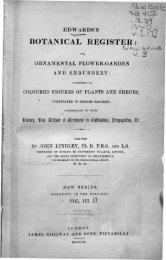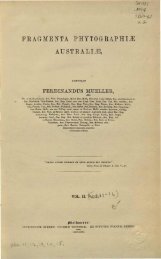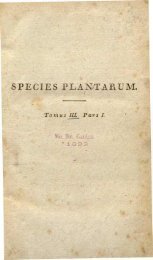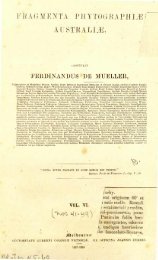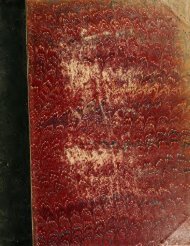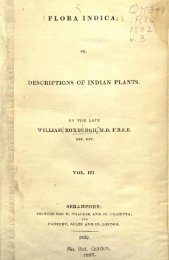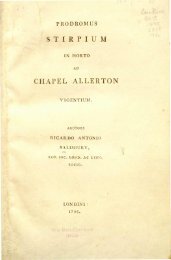Botanical Magazine 106 - 1880.pdf - hibiscus.org
Botanical Magazine 106 - 1880.pdf - hibiscus.org
Botanical Magazine 106 - 1880.pdf - hibiscus.org
You also want an ePaper? Increase the reach of your titles
YUMPU automatically turns print PDFs into web optimized ePapers that Google loves.
TAB. 6508.<br />
STENOMESSON LUTEOVIBIDE.<br />
Native of Ecuador.<br />
Nat. Ord. AMAEYLLIDACE/E.•Tribe PANCEATIE^E.<br />
Genus STENOSIESSON, Herb.; (Baker in Ref. Bot. sub t. 308.)<br />
KTENOMESSON (Coburgia) luteo-viride; bulbo globoso tunicis membranaeeis<br />
brunneis collo elongato cylindrico semipedali, foliis synanthiis lineari-loratis<br />
viridibus, scapo aneipiti terminali sesquipedali, umbellis 5-G-floris pedicellis<br />
brevibus, spatbse valvis magnis ovato-lanceolatis, perianthio luteo-viridi 4-<br />
pollicari, ovario oblongo, tubo subcyliiidrico, segmentis oblongis cuspidatis tubo<br />
2-3-plo brevioribus, filamentis dimidio inferiori in coronara coalitis margine<br />
inter filamentorum partem liberam dentibus deltoideis integris vel obsjure<br />
dentatis prsedito, antheris fulvis lineari-oblongis, stylo exserto.<br />
This is a new species from the high Andes of Ecuador,<br />
which flowered for the first time in the spring of 1879 with<br />
Messrs. E. Gr. Henderson and Son, of the Pine Apple<br />
nurseries, M aida Vale. It is nearly allied to the well-known<br />
Coburgia trichroma of Herbert (Bot. Mag. tab. 3867), and<br />
quite similar to it in its cultural and climatic requirements.<br />
The present plant differs from trichroma in the colour of its<br />
flowers and by its longer corona and more acute green<br />
leaves. There does not appear to be any valid character to<br />
separate Coburgia as a genus from Stenom-esson, and the<br />
latter has the claim of priority. I do not think we can<br />
properly regard the first six species of Coburgia as admitted<br />
in Kunth's Synopsis as more than mere varieties of the<br />
plant that was first described by Ruiz and Pavon in 1802<br />
under the name of Pancratium variegatum.<br />
HESCE. Bulb globose, two or three inches in diameter,<br />
with thin brown membranous tunics, which extend up the<br />
cylindrical neck to a length of six or eight inches. Leaves<br />
about four, contemporary with the flowers in spring, linear-<br />
lorate, fleshy, bright green, glabrous, a foot long at the<br />
flowering-time, an inch broad, narrowed gradually to the<br />
AUGUST 1ST, 1880.




